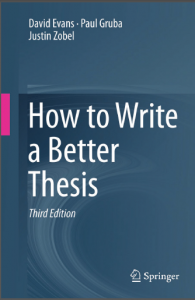By Madeline Walker
David Evans, Paul Gruba, and Justin Zobel. (2014). How to Write a Better Thesis, 3rd edition. [e-book]. Springer. 173 pages.
When you hit a snag or are feeling lost in writing your thesis, reading a “how to” book can be just what you need. Such a book might give you a new perspective, a fresh idea, great advice, or motivation to continue. I recommend you have a look at the e-book How to Write a Better Thesis, free and easily accessible in UVic’s library. Writing in a friendly and knowledgeable collective voice, Evans, Gruba, and Zobel cover every stage of the thesis-writing journey. Surprisingly, they recommend you start by exploring the end-point. Look up institutional expectations for the finished thesis (get guidelines from your department). Then, read theses in your field (this is easy for UVic students; just access UVicSpace and search). These investigations will orient you to thesis-writing’s big picture.
Part of big picture thinking is recognizing that dissertation writing is not a logical, linear journey. Evans et al. (2014) acknowledge that this journey involves both the left and the right sides of our brains: “the process of research is often not entirely rational. . . . Research is a mixture of inspiration (hypothesis generation, musing over the odd and surprising, finding lines of attack on difficult problems) and rational thinking (design and execution of crucial experiments, analysis of results in terms of existing theory) . . . without the creative part, no real research would be done, no new insights would be gained, and no new theories would be formulated” (p. 10, emphasis added). This claim resonates with my own experience of writing the dissertation: moments of serendipity and light-bulb flashes punctuating long periods of reading, research, and painstaking writing.
Another example of how these writers home in on the big picture is their discussion of aim and scope, where they show how writers sometimes conflate research methods with aims. Using a cogent example of a student named Alistair, they quote what Alistair has identified as the aim of his thesis about attitudes toward a marginal group in Japanese society called the burakumin:
The aim of the research is to establish which groups of mainstream Japanese continue to harbour anti-burakumin attitudes, analyze what those attitudes are and why they have remained extant, and to investigate which political measures are needed to solve the problem. (p. 64)
Evans et al. (2014) rightly ask, “what was the real aim?” and go on to show that Alistair has crammed four aims into one sentence:
- to establish which group has attitudes,
- to analyze attitudes,
- to determine why they persist,
- and to investigate measures to solve the problem.
According to Evans et al. (2014), the first three “aims” should not appear in the intro chapter, but in the research design chapter. They go on to explain that a common problem for graduate students is that they have too many aims and should identify only one aim that follows as a “logical consequence of the problem statement” (p. 65). Finally, the conclusion should respond to this aim. So, in a nutshell, they say “stick to a single paramount aim” (p. 65, emphasis in original). This is simple but excellent advice. Less is more.
This book has many strengths:
- The book is well organized, with introductory chapters on structure and mechanics followed by chapters on each section of the dissertation.
- The authors are practical and sensible on mechanics; for example, if you are wondering what style is permissible in your writing, “go to the top five journals in your field and determine what style is used. Look, too, at the use of voice to see if it is first person singular, active (‘I investigate’) or perhaps third person passive (‘the event was investigated’). If your work is cross-disciplinary, settle on a single style so that your work is consistent” (p. 29).
- They provide a comprehensive final checklist, “Dotting the ‘I’s and Crossing the ‘t’s” to review before you submit (pp. 129-136).
- Summaries are provided at the end of each chapter, so it’s easy to dip in and out of the book and choose only what is relevant to your thesis-writing journey.
Although the authors write from an Australian perspective and they claim their book is suitable mostly for students in the physical, biomedical, mathematical, and social sciences, I believe this book has nuggets of good advice for all thesis writers.
Note: “Thesis” in this book is an umbrella term covering both the master’s thesis and the doctoral dissertation.
About Madeline
Madeline Walker is the Coordinator of the Centre for Academic Communication. She has a PhD in English and enjoys helping students to engage fully with their writing. She loves red and purple, colours of the heart. 
